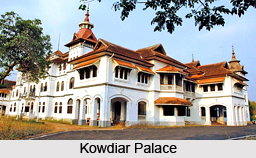 The Kowdiar Palace is one of the unique royal palaces in the Indian state of Kerala. The palace is nestled at the centre of the city of Thiruvanathapuram and palace is mainly known for the architecture. Built for late Maharaja Sree Chitra Thirunal Balarama Varma, this royal palace is at present occupied by the family members of the royal family which restricts the movement of tourists in the palace.
The Kowdiar Palace is one of the unique royal palaces in the Indian state of Kerala. The palace is nestled at the centre of the city of Thiruvanathapuram and palace is mainly known for the architecture. Built for late Maharaja Sree Chitra Thirunal Balarama Varma, this royal palace is at present occupied by the family members of the royal family which restricts the movement of tourists in the palace.
History of Kowdiar Palace
The Kowdiar Palace was built in the year 1934 by the Travancore Thamburan Sri Chithirai Thirunal, on the occasion of the wedding of his only daughter, Maharani Karthika Thirunal Lakshmi Bayi. The Constitutional Amendment of 1971 led to the partition and division of the properties and estates of the royal family equally among the branches of the two Travancore Queens, Sethu Lakshmi Bayi and Sethu Parvathi Bayi. The Kowdiar Palace belongs to the heirs of Sethu Parvathi Bayi as it was established by her son Maharajah Sree Chithira Thirunal.
Attractions of Kowdiar Palace
Kowdiar palace is one of the well known sites in Thiruvananthapuram which depicts the architectural superiority of the palace. The palace has over 150 rooms, wooden lift, and 6 steeples. It is one of the finest examples of observing Kerala Architecture. Though not open for public, this is one of the most colourful sights of the city.
This official residence of the royal family is surrounded by Raj Bhavan, Trivandrum Golf Club, Kanakakunnu palace and Napier museum. All these are the other important sights in Thiruvananthapuram. Enveloped with greenery, this palace is one of the most attractive sights in Trivandrum.
Visiting Information of Kowdiar Palace
The palace is well connected via airway and railway. The nearest airport which is Thiruvananthapuram International airport is located approximately 14 km away. And the closest railhead is the central railway station, 6 km away.
This article is a stub. You can enrich by adding more information to it. Send your Write Up to content@indianetzone.com



















